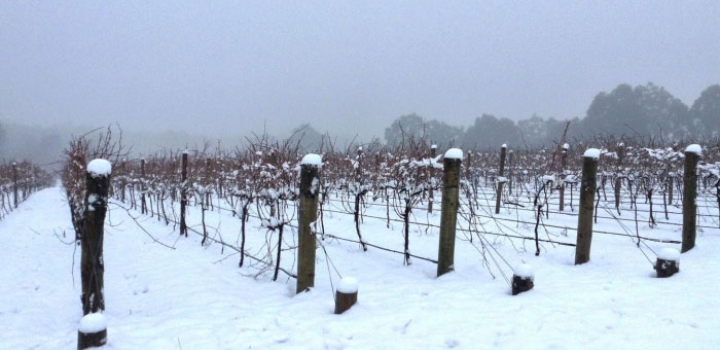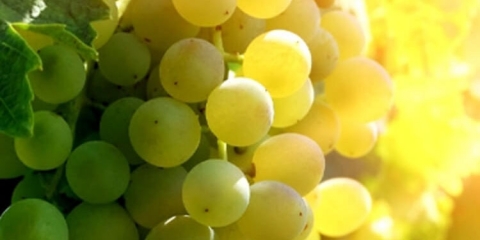
By Neil Prentice
‘Terroir’ is a bit of an overused, yet misunderstood term in wine circles. To me, it’s about the mineral AND microflora content of the soil, both the macro and micro climate of the vineyard, the way vines face the sun and the wind and how the vigneron nurtures their vines.
Soil
The Holly’s Garden vineyard is grown on deep volcanic, basalt soils. These deep red soils are rich in minerals, particularly iron. Typically wines grown on these soils are robust in flavour.
Care needs to be taken that the vines do not become excessively vigorous because of the mineral rich nature of the soil. Careful and intensive management of the vines is required to ensure that the vines don’t crop excessively and to ensure the green canopy is not to dense, both shading the fruit from sunlight (which can cause excessive green, vegetal flavour in the wine) and to ensure mould and mildew are not allowed to flourish in the shade and humidity of the canopy.
Microflora
Soil microflora play a huge role in assisting grapevines to access mineral nutrients in the soil. It’s very much a symbiotic relationship, with sub soil fungus growing into the vineroots, exchanging the minerals the fungus access’s with the energy in the vine’s sap carries that is produced by photosynthesis. This relationship is severely damaged by the use of systemic fungicides, artificial fertilizers, pesticides and herbicides. The microflora in the soil also assist dramatically with water retention and carbon sequestration.

Macro Climate
The Holly’s Garden vineyard is 750 to 850 meters above sea level, on the Buffalo high plateau. It’s not cool, it’s cold. It’s also a continental climate rather than a maritime climate so it doesn’t have the moderating influence of the surrounding bodies of water. Nights can get quite cold and this helps to slow the ripening process and give ‘hang time’ to the grapes. This extended time on the vine allows the fruit to ripen extremely slowly, building flavour, whilst retaining natural acidity and not building sugar levels before ‘flavour ripeness’.
To my mind Whitlands is THE BEST region in Australia for growing sparkling base. It seems wiser heads than mine agree with the recent acquisition of the Brown Brothers Whitlands vineyard by Domain Chandon. I’m extraordinarily proud of the sparkling wines we produce from the Holly’s Garden vineyard.
Whitlands sparkling base has pronounced acidty. It also combines the contradiction of robust, yet elegant and persistent flavour.
Whilst wine geeks almost unanimously concur that Pinot Noir is incredibly fussy about where and how it’s grown it seems very few pay such consideration to its sibling, Pinot Gris. From my personal experience I’d say its even more demanding about its ‘terroir’. Over the past decade Pinot Gris has grown from an old world curiosity, to a sought after fashion victim. Now the pendulum of opinion is swinging against it a little. My honest opinion is that is because vast swathes of Pinot Gris have been planted in warm to hot climates, producing flabby, flavourless wine with no structure and excessive residual sugar to compensate for it’s bland failings.
The macroclimate at Whitlands gives us Pinot Gris with fabulous pear and quince flavour, ginger spiciness and fabulous Granny Smith and Golden Delicious crunch and acidity. It’s the natural acidity that distinguishes Holly’s Garden Pinot Gris.
Micro Climate
We often hear of vines ‘facing the morning sun’. In the old world the most distinguished vineyards face South East, in the new world, North East. The morning rays will evaporate the dew from overnight humidity. The dual effects are to reduce disease pressure by reducing the humidity in the vine canopy as well as kick starting the photosynthesis as the leaves absorb CO2 and produce energy. Vines which have a Westerly view suffer a little more disease pressure as well as being exposed to the angrier afternoon sun. Vines which face away from the sun suffer significantly more exposure to mildew due to shading as well as running the risk of producing under-ripe fruit.
Wind is another important factor in micro climates. Gentle breezes can help reduce the pressure of mildew by drying out the canopy. Aggressive wind can dehydrate and stress vines excessively. The Holly’s Garden vineyard faces North East with a slope behind it to the South and forest to the West, sheltering from South Westerly winds but not from ugly Summer Northerly’s, Though these are moderated by the cooling influence of the altitude of Whitlands.
The Vigneron
The work of the vigneron has a huge influence on ‘Terroir’. The great wines of the world taste not only of where there from, but of who grew the grapes and how they were made.
Rachael’s work in the vineyard is tireless, but also based on her qualifications as a viticulturist, her knowledge of the region she’s lived in all her life, her instinctive feel for the relationship between nurturing the vines and the quality of the resultant wine.
Arched cane pruning gives a much more even budburst and even growth. Pruning will also affect the density of growth and resulting shading, air-flow and sun exposure of the fruit. How the vines are trellised and the canopy managed (vertical shoot positioned in this instance) affects whether the sun penetrates the canopy or the fruit is shaded.
Our work in the winery also has an impact. Winemaking needs to be empathetic to the demands of the fruit. We need to ‘listen’ to the fruit. The winemaker needs to find a balance of leaving things to take their natural course but also intervening appropriately, allowing the wine to express all of the influences that have come before.




